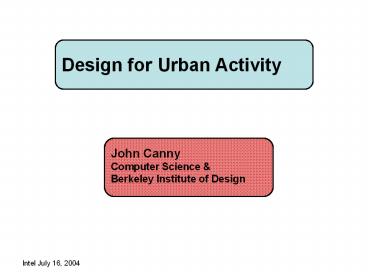Design for Urban Activity - PowerPoint PPT Presentation
Title:
Design for Urban Activity
Description:
... but poses great privacy risks. ... Communal Computation & Privacy Automation looks promising (think collaborative filtering) for everyday design, ... – PowerPoint PPT presentation
Number of Views:95
Avg rating:3.0/5.0
Title: Design for Urban Activity
1
Design for Urban Activity
John Canny Computer Science Berkeley Institute
of Design
2
Design for Urban Activity
- IT designers normally think about
- User needs, goals, tasks, actions (e.g. design a
ticket machine for BART) - The users intent is clear, and success is
well-defined
3
Design for Urban Activity
- Design for everyday life on the other hand
involves - User desires, motives, awareness
- Environment (surroundings)
- Context immediate and implied
- Improvisation, situated action
4
Urban Activity
- Some examples of urban activity
- Hanging out with a group of friends
- Presenting a persona
- Looking out for bargains wish-list items
- Looking for a partner/date
- Learning the environment landmarks, best place
for XXX
5
Activity
- We are guided by a pragmatic interpretation of
activity theory from Russian psychology. - Human behavior is viewed as an ongoing process
with a stable structure involving people, a
motive or object and the tools (often
information objects) that they use. - Activities are threadsthat span time and space
6
Activity maps (with X. Jiang)
Dating activity
People
Self
Date
Prospect
Mutual friend
Information objects
Movie info
Restaurant guides
Tools
Car
Cell phone
GPS gadget
Places
Home
Restaurant/Cafe
Venue
Times
Evening/weekend
Daytime
7
Using activity maps
- The activity map is a pattern, and makes use of
patterns to define its elements (people, tools
etc.) - We use a method called technology probes to
involve users in the design process. - A technology probe is an app that is given to
users early in the process, that encourages
adoption and experimentation.
8
Technology probes
- To simplify use of the technology probe, we use a
method called factoring functionality. - e.g. for location-aware services, we factor
complex apps into a few nouns and verbs - Nouns people and places
- Verbs read, write, listen-to, stream-to,
search-for - Most existing location-aware apps can be built on
these primitives, and we hope new ones will be
discovered.
9
Technologies
- Native XML-server hosts map data and user data.
Allows fast implementation of new designs (as
queries rather than code), arbitrary data types. - GPS-enabled smart phones (Motorola i830 with
Java) run a vector-graphics browser to support
server generated apps (no client code).
10
Automation modeling activities(w/ T.
Rattenbury, S. Sorkin)
- We are also developing models to infer activities
as patterns in user log data. - The model we developed is GAP (GAmma-Poisson)
- X is an activity, Y is a hidden affinity for
some items, and F is use of those items (e.g.
email to someone, going to a place).
11
GAP and discrete data
- GAP was developed to model user activities from
desktop and mobile log data. - We have developed a logger for windows which
tracks your email, file use and web access. - Because of deep connections between activity and
texts, GAP also works very well as a document
model. It is the most accurate B.O.W.
probabilistic model on standard (TREC) data
Canny SIGIR 04.
12
Communal Computation Privacy
- Automation looks promising (think collaborative
filtering) for everyday design, but poses great
privacy risks. - We have several new results on private
computation that in principle allow us to do
collaborative computation with very strong
privacy protection (IEEE SP 2002, Eurocrypt
2004, PET 2004).
13
Privacy (w /S. Sorkin and T. Duan)
- Privacy is typically approached from at least 4
disciplinary perspectives Ubicomp 02, 03, 04 - Technical
- Economic
- Legal
- Social
- A recent workshop on the economics of privacy
SIMS 02 underscored the difficulties - Almost all economic forces favor
information-gathering by companies about their
customers.
14
Social Incentives
- In contrast to legal and economic realms, in the
social arena things look promising. - P2P, Napster-style file-sharing is a fascinating
social phenomenon where a small population within
a social group contribute substantial resources.
- This suggests a novel approach to privacy
protection with peered servers PFP or
Peers-For-Privacy.
15
Peers For Privacy
- In PFP, a group of users elects some privacy
providers within the group. - Privacy providers provide privacy when they are
available, but cannot access data themselves.
U
P
U
U
S
U
PeerGroup
P
U
U
16
PFP
- PFP relies on the mutual distrust between a
corporate service provider, and peers from a
community. - Their lack of trust creates a very trustworthy
consortium.
P
S
PeerGroup
P
17
PFP
- With two or three hosts in a secret-sharing
glitter, private computation is almost as
efficient as a single-machine computation. - The server can still provide personalized
services, but only through pull operations from
clients.
U
P
U
U
S
U
PeerGroup
P
U
U
18
PFP
- PFP supports simple anonymization through to full
encrypted computation efficiently. - We plan to roll out PFP with our location-based
technology probe (for smart phones) later this
year.































